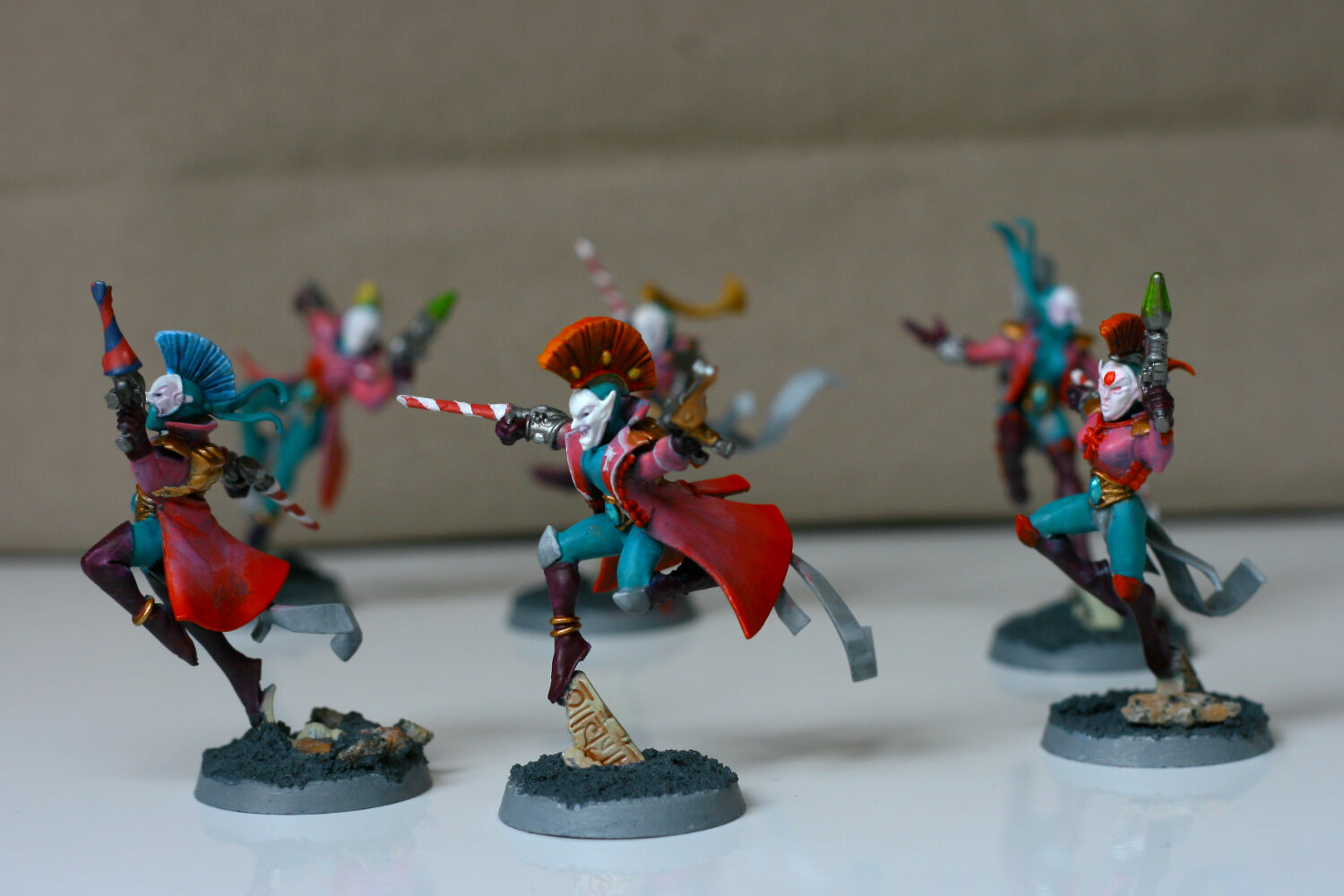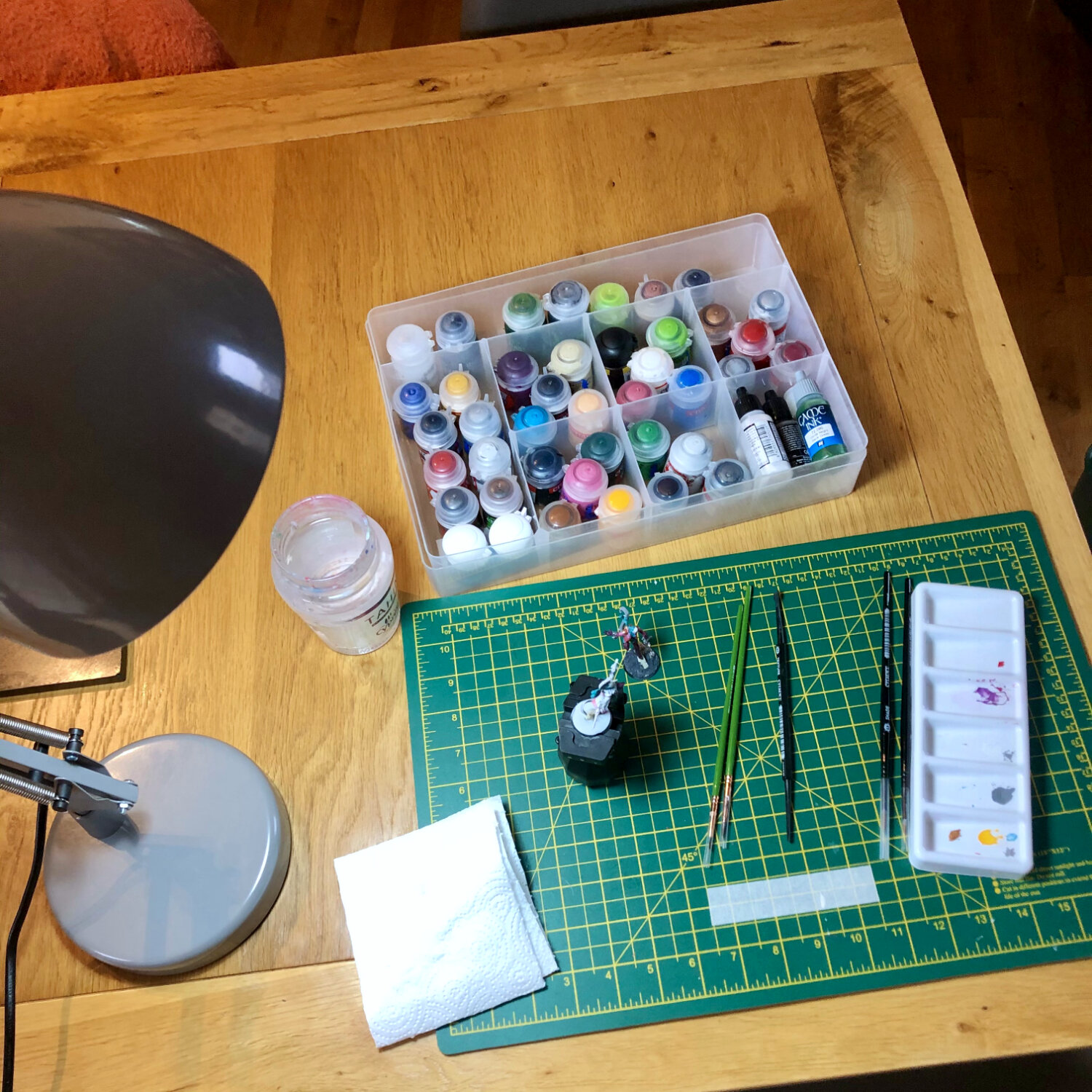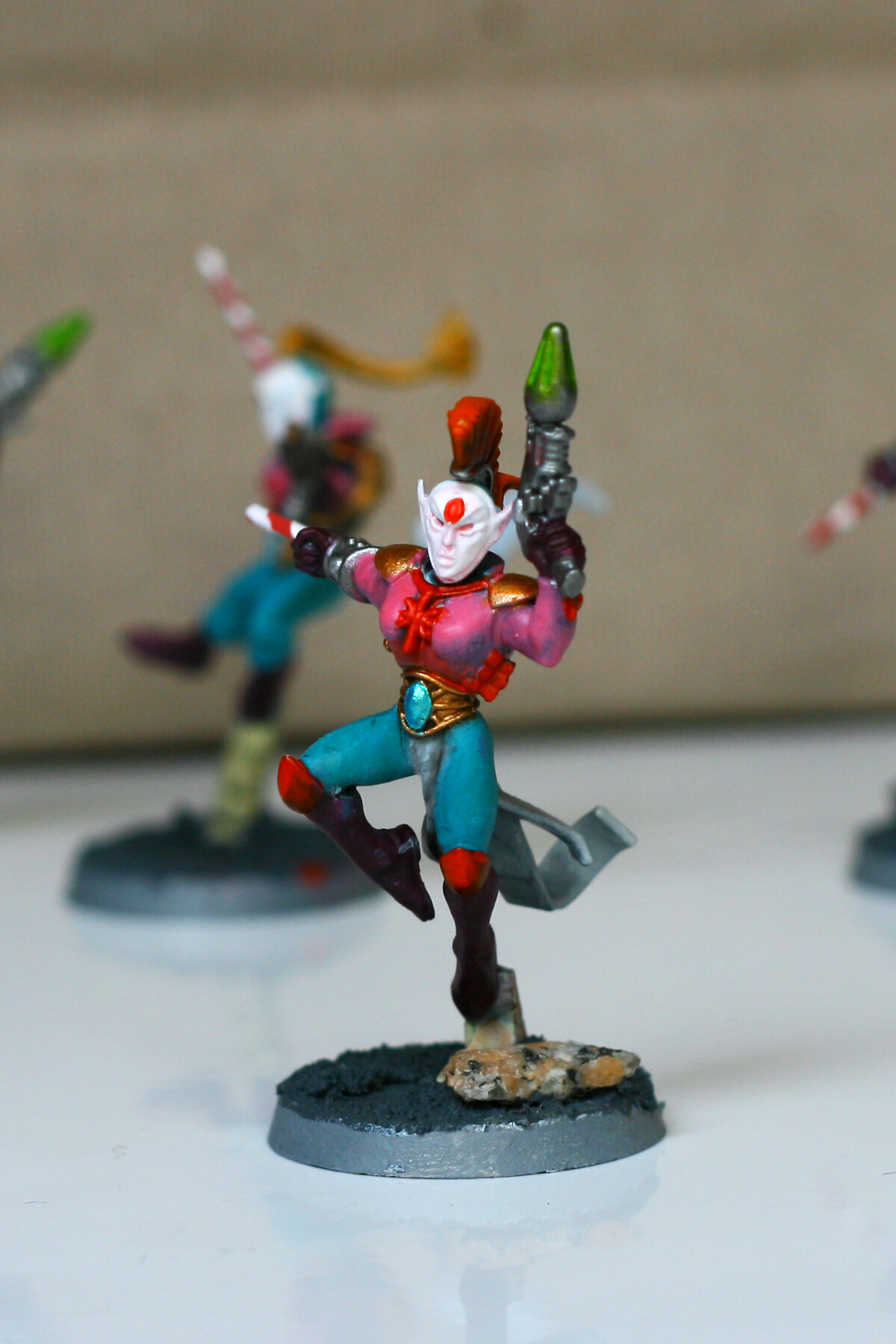Some things I learned painting six miniature murderclowns
In Warhammer 40,000, Harlequins are like a rogue community theatre project that murders you in the face. Little athletic battle clowns that serve a deranged trickster god through a combination of violent ballet and ridiculous trousers.
Out in the more dour and plague-addled real world, they are small plastic models made by Games Workshop, that you assemble, paint, and maybe one day get round to actually using to play a tabletop wargame with a gloriously daft high-gothic sci-fi setting.



Like many people I know, I played Warhammer as a teenager, lapsed, and sort of half kept an eye on it over the years. Underlying this was a grim certainty that one day the rising curves of disposable income and coolness of the models would intersect and I’d be back on my bullshit, daubing gaudy colours over some fey spiky bois.
Now, Games Workshop’s share price hasn’t quite tracked the Covid curve, but clearly it’s not just me and my friends that had a little miniature-painting shaped breakdown and went in hard on battle dollies in this the hell year 2020.
When I picked up some models again in September, I’d not painted in about twelve years. In 2008 I was terrible. Let’s not talk about when I first tried in ~1997 either.
This time I actually put a little bit of effort into getting better.
I cannot stress enough that this isn’t a guide to painting, or a getting started tutorial. It’s literally just some things I learned painting six models to a standard that for once I was actually happy with.
Here goes.
Do the homework
Painting something ok-ish in 2020 wasn’t magic, I’d just done my homework. Before, I’d dashed in all Dunning-Kruger “how hard can it be”, learning from self-taught friends, and assuming I knew best if something made first-principles sense despite my utter lack of domain expertise.
My literal best 2008 paint jobs. Do not ask to see the worst.
If you click through to the about page, you will see that yes, indeed I am a white man from the tech sector…
This time round, I made a very rough plan for what I wanted to do, thought about whether I knew how to do it (I didn’t), and went about filling in the knowledge gaps. You know, like a functioning adult might.
Arguably, what's really changed since 2008 isn’t that I’ve got any less hubris, it’s more there’s a load of great stuff on YouTube.
I mean, it's also radicalised a bunch of horny teens with no self-awareness into trigger-happy misogynists, fueled climate catastrophe denial, enabled the rise of global fascism, and legitimised that upsetting frothy instant coffee. But it's pretty great once you scrape off the fash.
There are a tonne of earnest, knowledgeable people out there now making high-quality, accessible tutorial content, and quite a lot of them probably aren't even Nazis.
I strongly recommend:
Billion dollar clown farm
(although I mostly think of him as Sad Ork Boy)
In particular, Dana Howl and Miniac do (in extremely different ways) really solid explanatory material that gets into how stuff works as well as what to do.
First, paint something
Wet blending: turns out it’s hard!
Decision paralysis is a thing. So is fear of failing. Insert inspirational platitude here.
Paint a length of sprue if you want to try a technique without risking a model (I have oodles of garishly wet-blended plastic shards), or buy some crappy older miniatures off eBay. Maybe a friend’s got eight million unpainted Skaven from 1995 and you can blag a couple? I have a handful of old metal Witch Elves from the early 2000s we use for trying stuff.
Paint something. All of that fail-fast-and-learn crap we talk about in product management, but rarely get to actually do.
Brace! Brace!
My hands shake a little. Even if yours don't, gripping and bracing properly gives you a lot more control over the brush. There's no right or wrong way to do it, and the aim is essentially to remove waggle freedom from all your waggly bits.
So you brace your elbows on a table, or wrists on a raised surface, or lean back and rest your hands and miniature on your chest. Or whatever works for you. You just don't want those arms out flapping. Or fingers – brace those against each other or the painting handle.
Get as much fine control over your brush fingers as you can.
This guy explains it far better than I ever will: Terrainosaur on painting with tremors
Get a handle
Grippy handle FTW!
Related to the point above. A painting handle gives you a load more options for gripping the model, and not getting in your own way or smudging your paint. GW will sell you one (obvs), as will several others.
You can make do with a bit of wood and some blu tac.
Counterpoint: depending on which you buy, you may keep catching it out of the corner of your eye and wondering who left a buttplug on the shelf in the living room. This is unsettling.
Make a wet palette (out of trash!)
Order spicy chilli oil beef, get bonus art supplies.
You don't need a wet palette, and you certainly don't need to buy one, but they do help and you can make one out of literal garbage. A plastic container with a lid, some paper towel, and some baking parchment will sort you right out.
But what is a wet palette and why should we care?
Well, there's a clue in the name. But basically it's for keeping your paints wetter for longer. This means you get more use out of them, which is especially handy if you don't want to buy too many and find yourself mixing a lot of your colours. They'll stay liquid on a wet palette for a couple of days if you put a lid on it.
A wet palette works by putting the paint on a semi-permeable layer (baking parchment in my case) over a wet sponge (kitchen roll), in a container you can put a lid on to keep it moist (an old takeaway carton).
There's a good explanation here
If you ant to buy one, I’m told the Redgrass one is good. It certainly looks like a funky mid-century design object.
I suspect they’re essential if you’re glazing…
Always be glazing
Glazing is working up colours in successive layers of highly-thinned paint.
All these layers came up kind of ok?
Thinning makes them more transparent, and the transparency means the colours or highlights/lowlights on the layers beneath show through. This allows you to build up delicate shading and rich effects. It's also incredibly forgiving to mistakes.
One of the main things I tried to do with the murderclowns was a gradient/ombre effect on their jackets. Initially I tried this with wet blending and it was a rancid pig to do.
Glazing? Literal fucking magic. It's like a cheat code for painting skill. For me at least.
The downside? It takes a while, and you really do need that wet palette, as those thinned paints are gonna dry like a motherfucker.
Don't bother zenithal priming
Zenith what now? Yeah, I know right. It sounds like fussy-ass bullshit when you first encounter it.
Zenithal priming (or highlighting) is using whites and greys in your undercoat phase, to mimic the way light falls from an overhead (zenith) light source.
Spray in black all over, than swoosh with a bit of white top down. Optionally add a middle stage of grey at an angle. It's a bit fiddly, and means you need more gear.
What it gets you is a model painted with sharp, severe shading. It looks a bit like it's stepped out of a black and white movie. All of this beautiful shading will then vanish in seconds as you slap on base coats of colour.
So it's a complete waste of time, right?
Well...
Try zenithal priming
Zenithal priming may be a waste of time if you're going to layer up thick colours. Maybe. If you're glazing it's a load of easy shading you won't want to miss.
Look at this black and white movie fucker.
(do not look at my horribly chipped nail varnish)
But more than that, it's a real confidence boost. A zenithal primed miniature looks like a thing, it starts to look real. And you did that! Plus, it gives a guide to where light and shade should go, and you can take a picture as a reference.
I did it in black and white (no grey) then follow some of Dana Howl's "underpainting" advice, adding some extra recess shade and touching up the highlights.
Zenithal priming (and underpainting) are absolutely worth it for me, painting as I'm painting now. I make no promises about what will work for you, or even me in a few weeks' time.
Wear gloves when you undercoat.
Seriously, I base coated over my nail varnish the first time. Especially if you're doing zenithal and therefore just that bit more buggering about with spray paints.
I have no idea if you actually need an airbrush
They’re all over the YouTube tutorials, and they do make a bunch of bulk jobs easier. On the other hand you're in the hole for at least fifty quid, probably a hundred for one that won't make you sad.
It’s also a whole new skill to learn, which could be fun, but I’ve still got so far to go with actual bristle brushes, so… yeah.
Plus, there are things I'd rather do with a hundred quid. That'll get you eight bottles of decent Beaujolais, or maybe three Primaris Space Marines.
A pot of (Citadel) paint costs about the same a shot and brings more lasting happiness
Seriously. The most expensive Citadel paint listed on their website is £4.75 for 24ml. That's the same as a premium gin at a non-fancy bar.
I'm not saying go wild, but if you know you're going to be using a lot of grey, say, maybe just buy a pot rather than mixing it every time. Also, the starter boxes are decent value, or you could do worse than grab a Vallejo starter pack. Near as I can tell Vallejo make decent mini paints, and their bottles have droppers which is nice for consistent mixing. We’re getting through loads of their metallic medium because the boyfriend is painting some incredibly camp Dark Angels.
The Citadel technical paints for basing are an absolute revolution in time/effort spent to good enough, too. Slap on some Mordant Earth and carry on with your life. Unless you enjoy the arts and crafts element of basing, in which case sure, why not.
Don't drink the Nuln Oil tho
I'm trying to kick my filthy brush-licking habit, it's a process.
Make notes & take pictures
I have a terrible memory. I do this with recipes, too – making notes as I go and taking process pictures is the main way I retain the actual detail of what went into the pot. Pictures in particular give you a couple of things: you can zoom in on something you're not sure about, and photos at the highlight stage can remind you where light and shade should fall.






The main thing I’ve taken away from this is pretty trite: there’s a quiet satisfaction in doing something until it’s done. There’s also a real joy in gradually becoming able to do something you didn’t think you could do.
I never thought I’d have the physical dexterity to edge-highlight a psychotic clown’s tiny little blazer lapels. Go me, and all that shit.
Painting models has given me some of the satisfaction I get from cooking, but with a whole different skill set, and less temporary results. I’m still only so so at it, but then I think about the first time I tried to make dinner for friends, back at the arse end of the nineties and next to that these six Harlequins are Turner Prize material.
Anyway I bought another box, so let’s see how the next batch go.
Speaking of which - a little shout-out to Element Games whose web store may feel a bit GeoCities, but who stock basically everything, deliver quickly, and will often discount Games Workshop minis and paints.